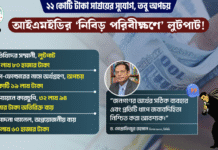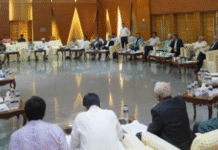
In her final days, Sheikh Hasina desperately clung to power as if she had full legitimacy, unmindful of a big crack in her armour. Her edifice crumbled a month ago on August 5. She fled Bangladesh, ending her iron-fisted rule of 15 years and leaving behind a legacy that established brutal authority over almost everything. A generation, to say the least, will remember her as a byname for intolerance to dissent, destruction of democratic institutions, rigged elections and utmost savagery in some cases. Sadly, her role in Bangladesh’s economic prosperity for which she was feted globally will be a faded memory.
The month leading to Hasina’s dramatic downfall was littered with death and destruction. Trigger-happy security forces, who were blamed for hundreds of deaths as the protests turned violent in mid-July, were out with full force. Videos of police shooting point-blank at nonviolent protesters emerged almost every day. Her brutal tactics led to an unprecedented bloodbath in any mass uprising in the region in memory.
Dystopian scenes vividly captured in photographs and videos by this newspaper as well as other media outlets will remain etched in our memory. Bangladesh became a symbol of nervous trauma. It was as if things were disintegrating from the centre. It also showed how peaceful protests lumbered into mindless mayhem. At one point, Hasina’s government ordered a complete shutdown of the internet, the modern-day lifeline, knocking daily life out of balance, and taking Bangladesh back to the forgotten analogue age. That didn’t quell the protests, started by university students but by now joined by people of every class and age groups, including women and children.
The government deployed platoons of paramilitary troops alongside the police to stem the ferocity of demonstrations with teargas shells, rubber bullets and gunfire. But the day wasn’t saved as one act of vengeance spawned another round of violence. Hasina’s party unleashed its youth wing on the streets to reclaim their turf. Bloodbath continued unchecked. The death toll climbed.
Hasina’s government admitted, for the first time, that they were pushed to the wall, a comment that came with horrific finality. It was a precursor to something more ominous — curfew. The deployment of the army on July 19, while it was undeniably necessary, tore the veil of stability that gave a fillip to the economy for more than a decade. The story of stability, sellable to foreign investors, lost much of its credibility. It also showed the government’s struggle in its new term to hold things together as Bangladesh hurtled into an uncertain future.
DAYS OF UNYIELDING ANGER
Protests, anger and vengeance inhabited the period from July 16 to August 6. With the passing of each day, protests turned more violent and the mob burgeoned. In speed and scope, the violence went far beyond anything Hasina believed possible. Government establishments and vehicles were set on fire and two metro stations were vandalised in Mirpur. For their part, law enforcement agencies unleashed aerial fury by raining down rubber bullets and teargas shells on protesters from the sky, a newfound tactic. Street vendors and pedestrians were unwitting victims of the government’s vengeance.
Ambulances, their sirens on, ferried the injured to hospitals, stretching health services in Dhaka and beyond. According to an initial count by the United Nations, 650 people were killed in Bangladesh with nearly 400 deaths reported from July 16 to August 4, and a further 250 in the new wave of violence between August 5-6. The health adviser in the interim government later said the death toll could be as high as 1,000. The Daily Star has so far been able to confirm more than 550 deaths.
The weight of the dead was too heavy. Shortly before midday, on August 5, Hasina was seen hurrying into a waiting helicopter in a disgraceful exit from Bangladesh. Her departure, which came after she lost the army’s support, sparked jubilation across the country. Millions of people descended on the streets to celebrate the fall of her government, a significant turning point in the nation’s history, amid dramatic and sometimes chaotic events.
As the news of her exit spread, the day became more volatile. The entire nation was in flux. Thousands of people stormed Gono Bhaban, the prime minister’s official residence, looting souvenirs, frolicking on the premises and grinning for selfies as they posed with the loot. People toppled a statue of independence leader and Hasina’s father, Sheikh Mujibur Rahman. Arsonists set fire to the Bangabandhu Museum in Dhanmondi, in what the Crisis Group said was “an act of grotesque retribution”. Reprisal attacks on Awami League leaders, sympathisers and religious minorities continued for the next few days.
It was almost unthinkable in January that Hasina’s government would fall apart, just seven months into her fourth consecutive term, however deeply flawed the election may be. But support for the government was clearly waning. The largest opposition force, the Bangladesh Nationalist Party, had boycotted the vote and turnout was conspicuously low. Global leaders were hesitant to congratulate Hasina on the win.
Hasina returned to power after winning the 2008 election in a landslide, but she seemed to have lost confidence along the way and rigged the subsequent three elections to hold on to power. And the regime became increasingly unaccountable for its wrongdoing. Internally, her overbearing presence hollowed out the party and other members lost their voices and roles. It morphed into a one-person party, and as such, a one-person government.
Hasina concentrated so much power in her hands and antagonised many who came into her orbit. The Awami League, which celebrated its 75th anniversary in June, and a party that has been a part of democratic movements from even before Bangladesh’s independence, the leading party in Bangladesh’s liberation war, seemed to have lost touch with the people.
Over time, Hasina who fits the playbook of a dictator became emotionally detached, unable to empathise with the suffering of people. This detachment manifested itself in increasingly brutal responses to anti-government protests. To maintain control, Hasina, like an isolated authoritarian ruler, often resorted to widespread surveillance and violent crackdowns on dissent. These factors created a feedback loop where her isolation exacerbated paranoia and repressive tendencies, ultimately leading to a more oppressive regime.
BEGINNING OF AN END
Protests erupted in Bangladesh in early July, when students began agitating against the reintroduction of controversial quotas for government jobs. The movement emerged amid widespread discontent with Hasina’s government, which had grown increasingly authoritarian and had badly mismanaged the economy.
“It was Hasina’s reaction to the protests that was her downfall. She sealed her fate when she decided to crack down rather than pursue dialogue with protest leaders,” the Crisis Group said in a report.
As demonstrations swelled across the country in mid-July, law enforcement agencies tried but failed to suppress the student-led uprising with the majority of them being young protesters. Police and paramilitary units used “unnecessary and disproportionate” force and resorted to extrajudicial killings, a level of political violence rarely seen in Bangladesh since its independence in 1971. Even after the Supreme Court drastically reduced the job quotas on July 21, protests continued to gather steam, advancing new demands, including accountability for the killings and the government’s resignation. That showed signs of Hasina’s troubles ahead.
On August 4, a final, terrible round of bloodshed before the collapse of the government left close to 100 people dead, most of them protesters shot by police and ruling-party members acting as vigilantes. The next day, hundreds of thousands heeded student leaders’ calls to march on Dhaka and poured into Shahbagh, defying another curfew. Just six kilometres away, Hasina packed up and fled Gono Bhaban. She found refuge in India, the next-door neighbour.
Daily Star










I must protest much of the language and “spin” put in this article. I do not know who wrote it (i.e., someone with some Awami League bias or not) but I got the distinct feeling that (1) the writer’s spin seems to be that thigs got out of control because Sheikh Hasina was reacting to the “ferocity” (word used by the writer) of the demonstrators. The real story was absolutely the opposite – it was the students and the people REACTING to the ferocity of the police/RAB/BGB, ordered by Sheikh Hasina to “shoot on sight”. I protest because some writers in Bangladesh try to showoff their knowledge of English by using wrong English words in the wrong place, and unclear sentences. This should STOP. They cannot create new reality by tryng to showoff their (lack of) knowledge of English and muddy the story.